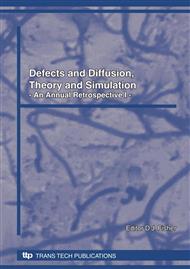[1]
Ling, F.F. (1973) Surface Mechanics, Wiley Interscience Publications, New York-London.
Google Scholar
[2]
Gladwell, G.M.L. (1980) Contact Problems in the Classical Theory of Elasticity, Sijthoff and Noordhoff, Alphen aan den Rijn.
DOI: 10.1002/zamm.19810611228
Google Scholar
[3]
Galin, L.A. (1982) Elastoplastic Problem, (LR. ) Nauka, Moscow.
Google Scholar
[4]
Mozharovsky, V.V. and Starzhinsky, V.E. (1988) Applied Mechanics of Composite Layered Bodies, (LR. ) Nauka i Tekhnika, Minsk.
Google Scholar
[5]
Johnson, K.L. (1987) Contact Mechanics, Cambridge University Press, Cambridge.
Google Scholar
[6]
Kalker, J.J. (1991) Viscoelastic multilayered cylinders rolling with dry friction, ASME, J. Appl. Mech., 58, 666-679.
DOI: 10.1115/1.2897247
Google Scholar
[7]
Goryacheva, I.G. (1998), Contact Mechanics in Tribology, Kluwer Academic Publishers.
Google Scholar
[8]
Antler, M. Processes of Metal Transfer and Wear, 7, 1964, pp.181-203.
Google Scholar
[9]
Calistrat, M.M. Friction between high speed gear coupling teeth, ASME Journal of Mechanical Design 103 (1981) 54-60.
DOI: 10.1115/1.3254883
Google Scholar
[10]
Radzimovsky, E., Mirarefi, A. Dynamic behavior of gear systems and variation of coefficient of friction and efficiency during engagement cycle, ASME Journal of Engineering for Industry (November) (1975) 1274-1280.
DOI: 10.1115/1.3438746
Google Scholar
[11]
Kragelsky, I.V., Friction and Wear, Butterworth Inc. Washington D. C, (1965).
Google Scholar
[12]
Iida, H., Tamura, A., Yamada, Y. Vibrational characteristics of friction between gear teeth, Bulletin of JSME 28 (241) (1985) 1512-1519.
DOI: 10.1299/jsme1958.28.1512
Google Scholar
[13]
Vaishya, M., Singh, R. Sliding friction-induced non-linearity and parametric effects in gear dynamics, Journal of Sound and Vibration 248 (4) (2001) 671-694.
DOI: 10.1006/jsvi.2001.3818
Google Scholar
[14]
Denape, J., Laraqi, N. Aspect Thermique du frottement : mise en évidence expérimentale et éléments de modélisation (2000), Méc. Ind, Vol. 1, pp.563-579.
DOI: 10.1016/s1296-2139(00)01068-x
Google Scholar
[15]
Barrau, O., Vergne, C., Rezai-Aria, F., Gras, R. Investigation of friction and wear mechanisms of hot forging tool steels (2002), in Proceedings of the 6th International Conference on Tooling, Karlstad, pp.81-94.
DOI: 10.1016/s0043-1648(03)00280-1
Google Scholar
[16]
Barrau, O. Etude tribologique de revêtement en régulation de turbines, Rapport TurbomécaENIT (1999) (in french).
Google Scholar
[17]
Robbe-Valoire, B., Baffoni, R. PROGRI, Load transmission by elastic, elasto-plastic or fully plastic deformation of rough interface asperities (2001), Mechanics of Materials, Vol. 33, pp.617-633.
DOI: 10.1016/s0167-6636(01)00074-6
Google Scholar
[18]
Mechergui, S., Sprauel, M., Blouet, J. and Maeder, G. Study of residual stresses during dry sliding of steel on steel, 8th leeds, Lyon symposium, Lyon, (1981).
DOI: 10.1016/b978-0-408-01226-3.50028-7
Google Scholar
[19]
P. CIBOIS, Analyse factorielle, P.U. F, Paris, (1983).
Google Scholar


